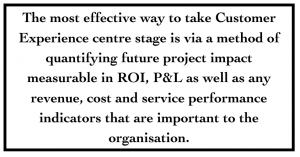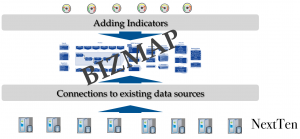The Customer Experience community desperately needs the ability to effectively measure its impact on company performance, way better than it currently can.
CX strategists are continually reporting incredible potential but take up, although increasing, is nowhere nearly rapid enough.
One CEO told me: “I look at 22 opportunities on average every month. I end up selecting maybe four. Why should I select Customer Experience when project owners cannot even quantify hard figure impact on the organisation?”
The Head of CX who I was sitting with protested. “But we can. Look at the studies in Forrester and Forbes amongst others. Look at the data we have collected here at XXX Limited. We have increased our Net Promoter Score by 7 points last year. Our revenue went up by 1%. Look at this expert study – it matches our findings!”
Is this a compelling argument from our determined Head of CX? In isolation, probably yes.
I would say that the CX Head in this example is one of the lucky 50% that are at least able to create some quantification of what impact CX could have on their organisation. The problem Mr CX Head has is he is quantifying the impact retrospectively, using data gained following implementation of another project. It is better than the remaining 50% who cannot quantify impact specifically enough, and therefore rely on working hard with senior stockholders on the conceptual benefits. Any CX Head will tell you that it is tough and frustrating, with decidedly mixed results.
I honestly believe what is available today is nowhere good enough. Here are some views:
- Approximately 80% of stakeholders will not buy concept unless its backed up with compelling social proof.
- Retrospective data driven proof is not good enough for most either. An argument which says “we deployed initiative X which drove an improvement of 7 NPS points and 1% revenue improvement” does not stack up well against the alternative arguments. Consider a Head of Ops who says “I have an operational excellence initiative which will reduce our cost base by 5 million USD within 6 months without compromising service levels”. Consider a Head of Sales who says “I have the opportunity to recruit 2 top industry performers who have exceed targets every year the last 3 years. We conservatively predict 3 million USD improvement to revenue against an extra cost of 500,000 USD. These are powerful arguments to pitch against.
- The only way for a Head of CX to pitch against stakeholders who do not completely buy the conceptual sell or “retrospective data analysis” style sell, is to create a business case which communicates to the stakeholder in precisely the language that is important to them. For many companies this will include the CEO who may publicly espouse the importance of CX, but will quietly sacrifice a CX objective in favour of P&L at quarterly or year-end time points.
Imagine if Mr CX Head is sitting with his C Suite colleagues and says “I have a programme that will increase our revenue by A, reduce our cost base by B, drive a ROI within C months, and increase our customer satisfaction scores by D”? Of course it depends on what the figures are for A, B, C & D but the first response has to be “we are listening”, followed by the question “can you prove it”?
Once the figures are proven then the obvious request is: “Take me through the latest Customer Experience concepts again. We have something we cannot afford to miss”.
This last bit is pretty obvious if you think about it. All you are doing is communicating the needs and value in the language of the target stakeholder. Guess what, this will vary quite considerably across functional silos, so in a world where consensus driven decision making is ever more the norm, all bases need to be covered.
Critical Success Factors
The market for Business Case Proof applications is likely to expand massively over the next few years. We see the driver will be a move from business analytics applications to a much more dynamic business operations management focus. The good news is the building blocks to do this are not only here, but already proven. What we have done is integrate the best change methodologies within CX, to a leading operations management application, to create a genuine business transformation capability. I hesitate in using the phrase “business transformation”, as it’s abused by people who drive a fraction of a percentage point in streamlining a business, but it is accurate here.
We started by defining some customer outcome based principles, critical to project success:
- There is no point creating the ability to measure business impact unless you have the ability to define effective CX driven change in the first place. Most Customer Experience change methods in use today are still quite suboptimal (a subject for another article). The application we built starts with the ability to build future states, using the latest approaches available to the market. This does not prevent the change teams from using their preferred approaches, but the most effective ones are included within the application.
- The application needs to be able to use information inputs that can be easily changed to simulate different business conditions. Any ROI or impact calculation is only as good as the business conditions that prevail at the time. It is often better to be able to represent a business case via a range of indicators rather than a single measure, with static assumed inputs.
- Ease of operation is going to be critical to users. Day to day analysis needs to be within the capability of the user. Ideally, set-up should require as little input from IT and support functions as possible.
- The user needs the ability to easily create and change different future states so simulated “what-if” analyses can be easily evaluated. Companies have different appetites for evolutionary scope and pace of change. Different future states need to be evaluated so the business impact can be quantified against risk appetite and time to deliver.
- The application needs to be flexible enough to support any revenue, cost and service performance indicator that is important to the stakeholder, and/or the organisation.
- Time to set-up needs to be quick – ideally within days
- The underlying model needs to be transparent enough to allow stakeholders the ability to easily validate.
We believe we have created an application that is quite unique. The problem with uniqueness is that organisations are wary of adopting unless the ability to validate is clear. Model transparency is therefore a prerequisite ahead of adoption.
How have we done it?
At the heart of the application is a process-centric change engine which effectively integrates customer journey and internal process into one place. The user has the ability to easily build current state scenarios and then create future states using the integrated change methods or their own preferred approach. This process model sits within an operational representation of the organisation which covers management, support, supplier functions, products and services, sales and delivery channels, customers and stakeholder definitions.
This central operational model is what we term a “Bizmap” and it is effectively a flexible and dynamic model of the entire organisation. It enables you to model elements of strategic CX driven change, using real time operational data, measuring impact through any key performance indicators of interest to the organisation.
Perhaps surprisingly, this is not a particularly complex exercise to set-up. We predict set-up time normally within 2 days for a mid-size organisation, possibly a day longer for a larger company.
The different data inputs are then configured using any or all of the data sources used by the organisation, in whatever structure that is already in place. Data inputs can either be the organisations own data or alternatively different data sets simulating different business scenarios; for example, more extreme business conditions may need to be strategically assessed.
Indicators are configured to represent any revenue, cost and service output. As long as the data inputs are available the performance outputs can be created, depending on the needs of specific stakeholders and the overall organisation.
At first glance this may appear like many Business Analytics applications. What we have actually created is considerably more dynamic, moving away from a series of single “performance snapshots” to a constantly changing environment which can be tested rigorously before critical decisions on change are actually made. In other words the approach is starting to enter the realms of true operations management, with the ability to assess different proposals more critically and more compellingly.
In summary:
- The central engine is highly flexible and allows company process and customer journey to be configured to as great a level of granularity as is required.
- The dynamic aspect of the configurator enables rapid changes to any aspect of the configuration, so differences in business performance can be directly assessed
- The application includes the latest methodologies to define CX driven future states so this represents a genuine CX driven business transformation and operations management solution.
This is intended to be a value driven article NOT sales driven. Yes, we are excited by the concept but everything we are doing is intended to be driven by the 3 key principles that should be adopted every time proposed change is considered:
- Can you achieve something that is in advance of what is already out there?
- Can you do it more quickly than before?
- Is it straightforward
If you have 3 answers of YES, then you have the basis of a decent proposition.



